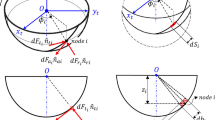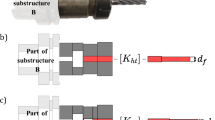Abstract
The monitoring of cutting forces during machining operations can provide information pertaining to tool wear and deflection. The cutting forces are influenced by the cutting parameters and system dynamics. To increase the efficiency of the cutting operations and to improve the quality of the finished products, the cutting parameters must be established within the stable limits of the machine tool. The identification of the dynamics of machine tools is therefore critical for ensuring a fast, efficient, and safe cutting operation. While the receptance coupling (RC) method is commonly utilized to determine the dynamics of machine tools and the chatter stability limits, its application necessitates multiple experiments in conjunction with finite element (FE) simulations, which can be complex and time-consuming to perform on a factory floor. To address these challenges, this study investigates the application of the artificial neural networks (ANNs) for predicting the frequency response functions (FRFs) of the tooling assembly. Multiple ANNs are trained to predict the FRFs of the tool-tool holder assembly, resulting in a significant reduction in the simulation time. The input and output training sets are generated using a validated FE software. Once the ANNs are trained, the predicted FRFs of the tooling assembly are combined with the FRFs of the machine through the RC method to obtain the tool tip dynamics.










Similar content being viewed by others
References
Quintana, G., & Ciurana, J. (2011). Chatter in machining processes: A review. International Journal of Machine Tools and Manufacture, 51(5), 363–376.
Mostaghimi, H., Park, C. I., Kang, G., Park, S. S., & Lee, D. Y. (2021). Reconstruction of cutting forces through fusion of accelerometer and spindle current signals. Journal of manufacturing processes, 68, 990–1003.
Schmitz, T., Betters, E., Budak, E., Yüksel, E., Park, S., & Altintas, Y. (2022). Review and status of tool tip frequency response function prediction using receptance coupling. Precision Engineering, 79, 60–77.
Nam, S., Hayasaka, T., Jung, H., & Shamoto, E. (2021). Proposal of novel spindle speed variation profile with constant acceleration rate for improvement of chatter stability. Precision Engineering, 68, 218–234.
Zhu, L., & Liu, C. (2020). Recent progress of chatter prediction, detection and suppression in milling. Mechanical Systems and Signal Processing, 143, 106840.
Hayasaka, T., Nam, S., Jung, H., Shamoto, E., & Saito, K. (2018). Proposal of accelerative cutting for suppression of regenerative chatter. CIRP Annals, 67(1), 401–404.
Altintas, Y. (2001). Analytical prediction of three dimensional chatter stability in milling. JSME International Journal Series C Mechanical Systems, Machine Elements and Manufacturing, 44(3), 717–723.
Wei, X., Miao, E., & Ye, H. (2022). Analytical prediction of three dimensional chatter stability considering multiple parameters in milling. International Journal of Precision Engineering and Manufacturing, 23(7), 711–720.
Sun, Z., Geng, D., Zheng, W., Liu, Y., Liu, L., Ying, E., Jiang, X., & Zhang, D. (2023). An innovative study on high-performance milling of carbon fiber reinforced plastic by combining ultrasonic vibration assistance and optimized tool structures. Journal of Materials Research and Technology, 22, 2131–2146.
Yihang, L., ZHANG, D., Daxi, G., Zhenyu, S., Zehua, Z., Zhefei, S., JIANG, Y., & JIANG, X. (in press). Ironing effect on surface integrity and fatigue behavior during ultrasonic peening drilling of Ti-6Al-4 V. Chinese Journal of Aeronautics. https://doi.org/10.1016/j.cja.2022.12.009
Yamato, S., Nakanishi, K., Suzuki, N., & Kakinuma, Y. (2021). Development of automatic chatter suppression system in parallel milling by real-time spindle speed control with observer-based chatter monitoring. International Journal of Precision Engineering and Manufacturing, 22, 227–240.
Bishop, R. E. D., & Johnson, D. C. (2011). The mechanics of vibration. Cambridge University Press.
Altintas, Y. (2012). Manufacturing automation: Metal cutting mechanics, machine tool vibrations, and CNC design. Cambridge University Press.
Kumar, U. V., & Schmitz, T. L. (2012). Spindle dynamics identification for receptance coupling substructure analysis. Precision Engineering, 36(3), 435–443.
Park, S. S., Altintas, Y., & Movahhedy, M. (2003). Receptance coupling for end mills. International Journal of Machine Tools and Manufacture, 43(9), 889–896.
Ertürk, A., Özgüven, H. N., & Budak, E. (2006). Analytical modeling of spindle–tool dynamics on machine tools using Timoshenko beam model and receptance coupling for the prediction of tool point FRF. International Journal of Machine Tools and Manufacture, 46(15), 1901–1912.
Akbari, V. O. A., Mohammadi, Y., Kuffa, M., & Wegener, K. (2023). Identification of in-process machine tool dynamics using forced vibrations in milling process. International Journal of Mechanical Sciences, 239, 107887.
Kim, S. W., Kong, J. H., Lee, S. W., & Lee, S. (2022). Recent advances of artificial intelligence in manufacturing industrial sectors: A review. International Journal of Precision Engineering and Manufacturing, 23, 1–19.
Wuest, T., Weimer, D., Irgens, C., & Thoben, K.-D. (2016). Machine learning in manufacturing: Advantages, challenges, and applications. Production & Manufacturing Research, 4(1), 23–45.
Chuo, Y. S., Lee, J. W., Mun, C. H., Noh, I. W., Rezvani, S., Kim, D. C., Lee, J., Lee, S. W., & Park, S. S. (2022). Artificial intelligence enabled smart machining and machine tools. Journal of Mechanical Science and Technology, 36, 1–23.
Özşahin, O., Budak, E., and Özgüven, H., "Estimation of dynamic contact parameters for machine tool spindle-holder-tool assemblies using artificial neural networks," Proc. Proceedings of the 3rd International Conference on Manufacturing Engineering (ICMEN), pp. 131–144.
Cherukuri, H., Perez-Bernabeu, E., Selles, M., & Schmitz, T. (2019). Machining chatter prediction using a data learning model. Journal of Manufacturing and Materials Processing, 3(2), 45.
Karandikar, J., Honeycutt, A., Schmitz, T., & Smith, S. (2020). Stability boundary and optimal operating parameter identification in milling using Bayesian learning. Journal of Manufacturing Processes, 56, 1252–1262.
Byun, Y., & Baek, J.-G. (2021). Pattern classification for small-sized defects using multi-head CNN in semiconductor manufacturing. International Journal of Precision Engineering and Manufacturing, 22, 1681–1691.
Surya, M. S., Prasanthi, G., Kumar, A. K., Sridhar, V., & Gugulothu, S. (2021). Optimization of cutting parameters while turning Ti-6Al-4 V using response surface methodology and machine learning technique. International Journal on Interactive Design and Manufacturing (IJIDeM), 15(4), 453–462.
Moreira, L. C., Li, W., Lu, X., & Fitzpatrick, M. E. (2019). Supervision controller for real-time surface quality assurance in CNC machining using artificial intelligence. Computers & Industrial Engineering, 127, 158–168.
Zhang, Y., & Xu, X. (2021). Machine learning cutting force, surface roughness, and tool life in high speed turning processes. Manufacturing Letters, 29, 84–89.
Greis, N. P., Nogueira, M. L., Bhattacharya, S., Spooner, C., & Schmitz, T. (2023). Stability modeling for chatter avoidance in self-aware machining: an application of physics-guided machine learning. Journal of Intelligent Manufacturing, 34, 387–413.
Schmitz, T., Cornelius, A., Karandikar, J., Tyler, C., and Smith, S., 2022, "Receptance coupling substructure analysis and chatter frequency-informed machine learning for milling stability," CIRP Annals.
Pawar, S., San, O., Nair, A., Rasheed, A., & Kvamsdal, T. (2021). Model fusion with physics-guided machine learning: Projection-based reduced-order modeling. Physics of Fluids, 33(6), 067123.
Lim, T. W., Cabell, R., & Silcox, R. (1996). On-line identification of modal parameters using artificial neural networks. Journal of Vibration and Acoustics, 118(4), 649–656.
Su, L., Huang, X., Song, M.-L., & LaFave, J. M. (2020). Automatic identification of modal parameters for structures based on an uncertainty diagram and a convolutional neural network. Structures, 28, 369–379.
Wu, J. S. (2013). Analytical and numerical methods for vibration analyses. John Wiley & Sons.
Rayleigh, J. W. S., & B., L. R.,. (1945). The theory of sound. Dover publications.
Mostaghimi, H., Hassani, M., Yu, D., Hugo, R. J., and Park, S. S. (2021). Dynamic stress analysis of exposed pipes subjected to a moving in-line inspection tool. Journal of vibration and acoustics, 143(5), 051007.
Chomette, B., & Mamou-Mani, A. (2018). Modal control based on direct modal parameters estimation. Journal of Vibration and Control, 24(12), 2389–2399.
Chomette, B., 2023, "MIMO modal parameters identification in frequency domain,"MATLAB Central file exchange (https://www.mathworks.com/matlabcentral/fileexchange/82380-mimo-modal-parameters-identification-in-frequency-domain), Retrieved Mar 14, 2023 .
MacKay, D. J. C. (1992). Bayesian interpolation. Neural Computation, 4(3), 415–447.
Strang, G., 2006, Linear algebra and its applications, Belmont, CA: Thomson, Brooks/Cole.
Hyndman, R. J., and Athanasopoulos, G., 2018, Forecasting: principles and practice, OTexts.
Acknowledgements
This study has been conducted with the support of the Korea Institute of Industrial Technology as "Automatic generation of machining process plan for mold parts based on artificial intelligence (KITECH JH-23-0008)".
Author information
Authors and Affiliations
Contributions
All authors read and approved by the final manuscript.
Corresponding author
Additional information
Publisher's Note
Springer Nature remains neutral with regard to jurisdictional claims in published maps and institutional affiliations.
Supplementary Information
Below is the link to the electronic supplementary material.
Rights and permissions
Springer Nature or its licensor (e.g. a society or other partner) holds exclusive rights to this article under a publishing agreement with the author(s) or other rightsholder(s); author self-archiving of the accepted manuscript version of this article is solely governed by the terms of such publishing agreement and applicable law.
About this article
Cite this article
Mostaghimi, H., Park, S.S., Lee, D.Y. et al. Prediction of Tool Tip Dynamics Through Machine Learning and Inverse Receptance Coupling. Int. J. Precis. Eng. Manuf. 24, 1739–1752 (2023). https://doi.org/10.1007/s12541-023-00831-6
Received:
Revised:
Accepted:
Published:
Issue Date:
DOI: https://doi.org/10.1007/s12541-023-00831-6




